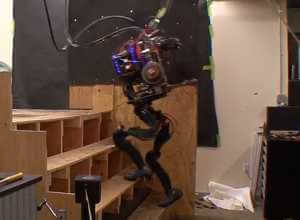
No sooner does DARPA lay down the Robotics Challenge gauntlet do they then entice would be entrants by giving them a glimpse of what they get to work with. DARPA released a video recently of their robot stomping impressively up a flight of stairs. If you’re not familiar, the Robotics Challenge is a competition in which the winning robot(s) will successfully carry out a set of tasks on a disaster simulation course. DARPA’s raising the bar with the course, requiring the robots to, among other things, drive a vehicle, climb a ladder, and identify and fix a leaky pipe. The winning team get $2 million and undoubtedly YouTube celebrity.
The competition is broken up into four tracks. Tracks A and D will build their own robot and develop their own software. But those who don’t qualify to get DARPA funding for their work in Track A will have to supply their own funding through Track D. Tracks B and C work similarly, except teams in these tracks will only develop software and use DARPA’s government funded equipment (GFE) – aka, the robot – as part of their platform.
The stairmaster was developed in collaboration with Boston Dynamics who, with their stock of rugged, can-do robots like Petman and Alpha Dog, have to be a favorite for the Challenge.
I’m really excited to see what solutions the world’s robotics developers unleash on the obstacle course. DARPA’s high-steppin’ robot in the video isn’t complete. A torso, arms, and a head will be added so entrants can climb that ladder and seal that pipe leak. The course is a seriously difficult challenge and most likely it’ll be a few years before a robot raises its arms – or arachnoid appendages – in victory. But one thing is clear, DARPA is serious about making that happen as soon as possible.
[image credits: DARPAtv via YouTube]
video credit: DARPAtv via YouTube]
images: DARPA
video: DARPA



